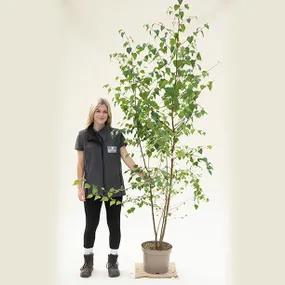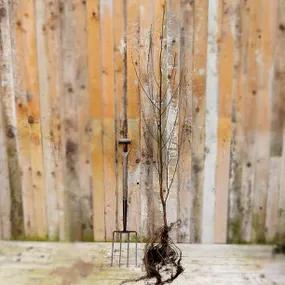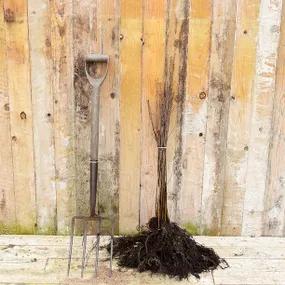Silver Birch Sapling Trees
Honest Delivery PricesBetula pendula
Sapling Trees- Native. White young bark, gentle weeping habit.
- Not for hedging. Good screening.
- Sizes: Saplings & Standards
- Max. Height: 25m
- Bareroot Delivery Only: Nov-Mar.
Recommended extras
Description
Betula pendula: Young Bareroot Trees
Delivered by Mail Order Direct from our Nursery with a Year Guarantee
Silver Birch, Betula pendula, is a fast growing, native tree with pretty white bark and an airy, semi-weeping canopy that casts light, dappled shade. It likes sunny sites, and will thrive on pretty much any soil except solid chalk. It is not suitable for hedging, and grows to about 25 metres.
The plants on this page are young saplings. You can also buy larger Silver Birch trees, browse all of our other varieties of Birch trees, or see our full range of hedging and saplings trees.
The pale, creamy-white bark of this elegant tree is its best feature, providing year-round interest. It has little diamond shaped, mid-green leaves with serrated edges, dangling in fluttering streamers of thin, hanging side-branches. These turn yellow in autumn, which looks fantastic next to the white bark with the sun shining through it all. It produces catkins in April and May, which release their seeds to the wind.
Silver Birch saplings are only delivered bareroot, during winter (Nov-March).
Choosing a size: When you are ordering a large quantity of Silver Birch for a big project, we suggest that you buy the smaller plants, graded at 60/80cm. They are cheaper than large plants, easier to handle and more likely to cope well with poor conditions. Use the larger sizes for instant impact in a garden.
All of our young trees and shrubs are measured by their height in centimetres above the ground (the roots aren't measured).
Features
- Likes full sun.
- Any soil, preferably on the moist side.
- White bark provides year round interest.
- Casts relatively light shade.
- Height: Vigorous to 25m
- Bareroot Delivery Only, Nov-March
Growing Silver Birch
In the wild, it is a pioneer tree that rapidly takes advantage of openings in a forest when other trees fall, and other open sites like river banks. As other, slower growing trees overshadow it, it begins to die, so it will suffer in more than a little shade.
Its favourite soil is deep, rich and moist, and it loves growing close to water, as long as it only waterlogs temporarily in winter. But, as long as it gets enough sun, it really isn't fussy, and will be fine on fairly poor, dry soil as well, especially if you help it along with good soil preparation and a yearly mulch in spring to conserve soil moisture in the early years.
Silver Birch in your Garden
As a screening tree, its fine branches and sparse foliage blur rather than obliterate whatever it is you are trying to hide. Because it only casts dappled shade, you have a wide range of options for things to plant under it, and it is perfect for bluebells.
It is debatable whether you want to train a climber up it, because this will obscure the white bark. A good choice here are Clematis in pruning group 3, which are hard pruned in February/March, so you will get a few weeks of lovely bare bark before the trees come into leaf.
They can be used to help regenerate a site with terrible soil. Being vigorous and relatively short-lived, they will quickly start laying down layers of leaves that rot down and improve the soil. In time, the soil will become fertile enough for other trees to thrive and by the time that they are mature, the birches will naturally be in decline.
Planting Instructions
Notes on planting Silver Birch:
Silver Birch trees will grow well in most soils, especially acidic ones. It prefers heavy clay and moist conditions; it will grow close to rivers and tolerates winter waterlogging. It is very hardy and although it will grow in exposed locations, it will get twisted by constant wind. It must have plenty of sun.
Silver Birch will not grow well on chalk.
Prepare your site before planting:
It is good to dig over the area where you intend to plant several months in advance. Destroy the weeds first: nettles, brambles and ground elder are tough. Then dig the soil over; remove rocks, roots and other rubbish. Mix in well rotted compost or manure down to the depth of about 2 spades.
If you have a heavy clay soil, it might be too difficult to dig over for most of the year. Heavy clay is fertile soil, so you don't really need to improve it; killing the weeds is still necessary.
Remember to water establishing plants during dry weather for at least a year after planting.
Planting accessories:
Prepare your site for planting by killing the weeds and grass.
If you are planting in an area with rabbit and/or deer, you will need to use a protective plastic spiral for each plant, supported by a bamboo cane.
If your soil quality is poor, we recommend using mycorrhizal "friendly fungi" on the roots of new trees and shrubs.
You can also improve your soil with bonemeal organic fertiliser.
After you plant your Silver Birch saplings, the most important thing to do is water them in dry weather. If you didn't use mulch of some kind, you will also need to weed around the plants. Both of these will be necessary for at least a year after planting.
Water thoroughly but not too often: let the soil get close to drying out before watering your plants again.
Special notes on caring for Silver Birch:
Silver Birch is a very tough plant that shouldn't need special attention once it has established.
Avoid pruning birch, unless you are growing it as a coppice tree (usually for firewood). Apart from the universal job of removing Dead, Diseased or Damaged branches, it's best to let your tree grow. Mature birch branches do regrow, but they don't do it gracefully! If you must prune birch, do it in early winter to avoid bleeding sap.
Hygiene & Diseases:
Dead, damaged or diseased wood can be pruned off as soon as it appears.
Disinfect your pruning tools between every cut if there is any sign of disease.
Burn or dispose of any diseased material, do not compost it.
Did You Know?
Known as Lady of the Woods in old stories, it was a very useful tree in the past. Its bark was used for covering boats, canoes or making the roof of a hut. A skilled worker could remove the outermost layer of bark without killing the tree: if you want to try your hand at this, late spring is the best time.
An unpleasant tasting but effectively alcoholic mead can be made from Silver Birch sap, which tastes like sugary water in spring. Its resin was boiled down to make a decent glue.
Today, it is sometimes used as a coppice tree for firewood, harvested every 3/4 years. It is one of the easiest firewoods, burning bright and hot even before it is fully dried. Artist grade charcoal is made from the bark.
Birch is the traditional material for making a sauna whisk, or vihta, which are used to gently flog your sauna buddy. As if any further reason were necessary to hit someone with a bundle of wet twigs, this is said to improve blood circulation, reduce muscle soreness, and enhance mood, at least for the person administering the therapeutic thrashing. These days, it is common to use Eucalyptus in the whisk.

 hedging 1.webp)
 hedging 1.webp)

 hedging 2.webp)
 hedging 3.webp)

